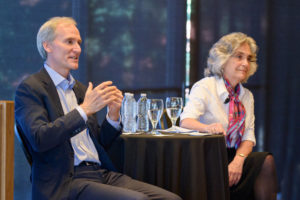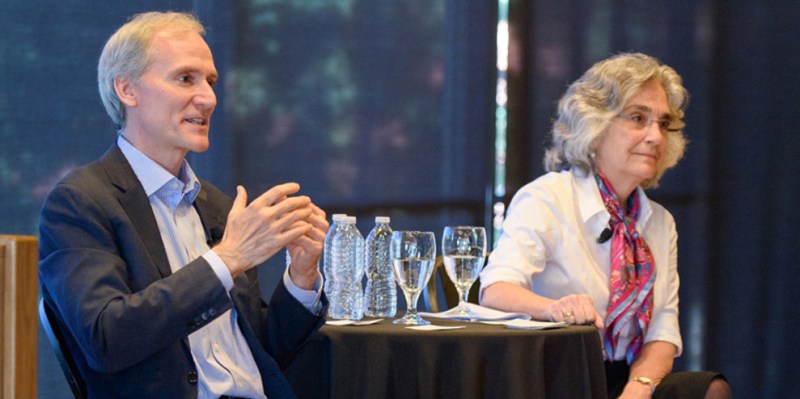On Thursday morning, Stanford’s long-range planning Area Steering Group (ASG) white papers were officially released and made viewable to Stanford affiliates.
The 37 papers represent the efforts of four ASGs to compile high-level summaries of the over 2,800 ideas and proposals submitted by faculty, staff, students and other members of the University community at large. The long-range planning process, launched early last year, seeks to crowdsource thoughts for Stanford’s future.

“The white papers demonstrate the depth of the University community’s engagement with the long-range planning process, the care with which the area steering groups have reviewed the proposals and our community’s commitment to making meaningful contributions to help solve large global problems,” University President Marc Tessier-Lavigne said in an interview with Stanford News.
The campus community now has a 30 day comment period to submit written feedback. The president and provost also plan to host University-wide discussions.
Content highlights
The four ASGs — Education, Research, Community and Engagement Beyond Our University — wrote documents covering a wide range of topics including diversity, educational equity and outreach, housing affordability, sustainability and more.
With over 100 members across the four groups, including both undergraduate and graduate students, staff, faculty and postdoctoral scholars, the ASGs helped organize, frame and editorialize the submitted ideas into a collective framework for Stanford’s future. These papers will ultimately inform the operational decisions made by the University’s Executive Cabinet as it processes the proposals in consultation with the Board of Trustees. The Executive Cabinet is comprised of the president, provost, deans, vice provosts and the directors of SLAC and the Hoover Institution.
“The white papers are the product of hours of hard work by the area steering groups and represent a synthesis of the thousands of ideas collected,” Associated Students of Stanford University (ASSU) President Justice Tention ’18 said.
Notably, the documents address the expansion of financial aid to provide need-blind admission for international students and increased educational accessibility for low-income applicants, as well as a re-imagining of the broad curriculum to increase undergraduate exposure to the humanities. Also emphasized were the need to instill a culture of inclusion and equal treatment, public service to both the local and global community and new research initiatives.
In a blog post, Tessier-Lavigne and Provost Persis Drell pointed to a number of overarching themes across each of the white papers, including “affordability, diversity and inclusion, health and well-being, and institutional accountability.” They added that sustainability was such a significant issue among the papers’ stakeholders that all four steering groups contributed to a paper on the subject.
“We wanted to ask everyone to dream big,” said Megan Pierson ’82, chief of staff to President Marc Tessier-Lavigne. “There [are] a lot of innovative ideas about how … Stanford [should] do things differently, and we want to be good stewards of [our] resources [and] how we can [use them] effectively.”
In their blog post, Tessier-Lavigne and Drell addressed the fact that several proposals express criticism of current practices at Stanford. They said they welcome such feedback and hope to use it to “create a collective vision for the future of Stanford.”
John Zhao ’18, a student representative on the Engagement Beyond Our University ASG, said the University should incorporate feedback from the white papers into its operational processes and investments.
“There is a sense that Stanford should not simply rely on its research as a way to address challenges, but to act responsibly through its investment decisions and operations on campus,” Zhao wrote in a statement to The Daily. “For example, rather than just doing research on the impacts of private prisons on incarcerated individuals, there was a call for Stanford to divest from companies that are implicated in the prison industrial complex.”
In an effort to address top concerns in areas such as housing affordability, employee compensation and institutional change, the Provost’s Office has already overseen a number of initiatives over the past few months. The University is currently working to implement flexible work arrangements to mitigate long commutes and lack of affordable local housing, as well as a project to improve student-faculty advising relationships for graduate students.
“We believe this process will make Stanford better and stronger as an academic institution,” wrote Tessier-Lavigne and Drell.
Strategy
Each submission to the long-range planning process was read by at least two ASG members per group, with no proposals excluded from the review process. Following ASG review, all proposals were forwarded to the Executive Cabinet, which works in collaboration with the Board of Trustees.
Pierson emphasized that each steering group worked independently from Executive Cabinet members and — with the exception of the jointly-crafted sustainability paper — from each other. Though the committees produced white papers with topical commonalities, she said, each group addressed recurring themes, such as equity and diversity, from their own specific angles.
“The net gain from that is we have four groups approach this in their own distinctive way for their own areas, which I think is really wonderful,” she said.
The Executive Cabinet will continue to review the white papers to construct a unified framework while the 30-day comment period is ongoing.
Both ASSU executives, Tention and Vicki Niu ’18, participated as ex-officio members of the Our Community steering group. Last spring, the pair presented to stakeholders on issues Tention described as “critical to students and the priorities of the ASSU.”
In a statement to The Daily, Tention said the white papers will ensure the policies, institutional changes and projects that the long-range planning process ultimately yields will reflect community members’ ideas.
“We appreciate the transparency of the President’s office in releasing the white papers in their entirety,” he wrote. “These white papers will hold the executive committee accountable in ensuring that Stanford’s long range plan addresses the desires and concerns brought about [by] the broader community.”
Our Community steering group member Isabelle Foster ’18 advocated the continued involvement of Stanford students in the long-range planning process.
“I think that it is encouraging that students have been brought on to the initial steering groups and were solicited for feedback,” she wrote in a statement to The Daily. “I hope that students will continue to be involved in the later stages as well.”
Zhao, however, criticized the long range planning process for its exclusivity on the committee level, citing the University’s process of selecting students to serve as part of the steering groups.
“I was able to apply to join the committee because I had access to limited information during a short time window,” he wrote in a statement to The Daily, saying that fewer than 10 students were selected to serve in total. “It seems unlikely that so few undergraduates could accurately represent the whole student body. While serving on a committee, I felt like my voice as a student was being tokenized and not being genuinely considered to the same level.”
Zhao also questioned the originality of proposed changes that the steering groups hoped to garner.
“Ultimately, many of the ideas submitted through this process are not new,” Zhao said. “Students have been asking and waiting for a while now. Hopefully, the Stanford administration will stick to their word and really listen to the community’s ideas.”
Contact Courtney Douglas at ccd4 ‘at’ stanford.edu and Claire Wang at clwang32 ‘at’ stanford.edu.
